Blackberry Strategic Analysis: Basic of Strategy, 2020
VerifiedAdded on 2020/11/10
|22
|7533
|743
Essay
AI Summary
This essay provides a comprehensive strategic analysis of BlackBerry Limited, examining its establishment, governance, and specialization in enterprise software and IoT. The analysis covers BlackBerry's mission, vision, and geographic presence, along with its sales, revenue, and competitive position within the smartphone industry. The essay explores the company's chosen differentiation strategy, its associated risks and issues, and an external analysis including industry scope, PESTEL analysis, Porter's Five Forces, industry life cycle, strategic groups, and key success factors. An internal analysis delves into the value chain, corporate strategy, and business strategy. The conclusion offers recommendations based on the findings. The essay highlights the decline in BlackBerry's market share due to competition from Apple and Android, the shift to software and security systems, and the need to adapt to the changing competitive environment. The PESTEL analysis identifies key factors influencing the smartphone industry, including political, economic, sociocultural, technological, environmental, and legal aspects. The essay also emphasizes the importance of sustainability and consumer privacy.

Université Paris Dauphine - 2020
Basic of Strategy
Blackberry – Strategic Analysis
Final Essay
Aybike Isik Muftuoglu
Aya Rachid
Zhuoran Zheng
Basic of Strategy
Blackberry – Strategic Analysis
Final Essay
Aybike Isik Muftuoglu
Aya Rachid
Zhuoran Zheng
Paraphrase This Document
Need a fresh take? Get an instant paraphrase of this document with our AI Paraphraser
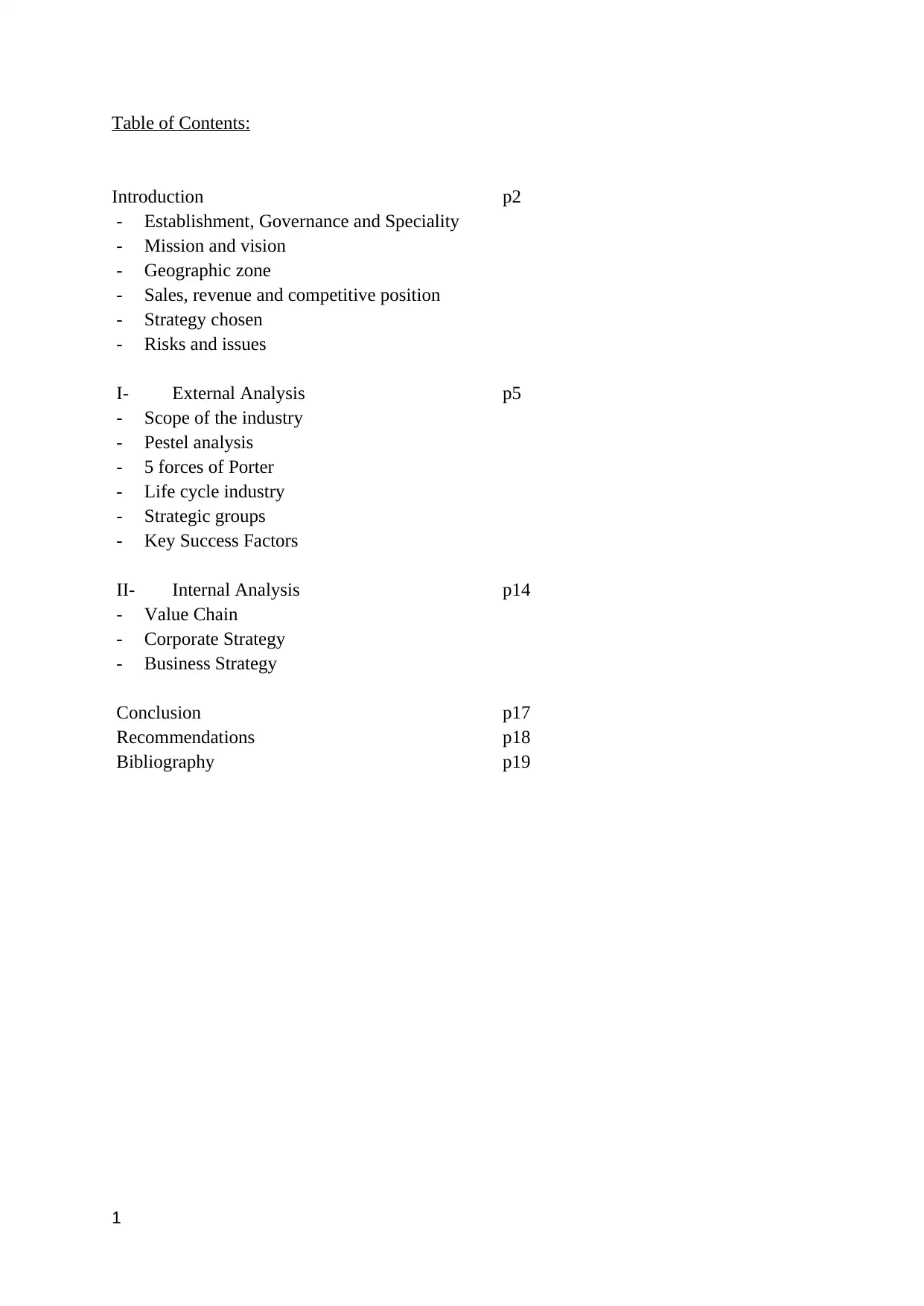
Table of Contents:
Introduction p2
- Establishment, Governance and Speciality
- Mission and vision
- Geographic zone
- Sales, revenue and competitive position
- Strategy chosen
- Risks and issues
I- External Analysis p5
- Scope of the industry
- Pestel analysis
- 5 forces of Porter
- Life cycle industry
- Strategic groups
- Key Success Factors
II- Internal Analysis p14
- Value Chain
- Corporate Strategy
- Business Strategy
Conclusion p17
Recommendations p18
Bibliography p19
1
Introduction p2
- Establishment, Governance and Speciality
- Mission and vision
- Geographic zone
- Sales, revenue and competitive position
- Strategy chosen
- Risks and issues
I- External Analysis p5
- Scope of the industry
- Pestel analysis
- 5 forces of Porter
- Life cycle industry
- Strategic groups
- Key Success Factors
II- Internal Analysis p14
- Value Chain
- Corporate Strategy
- Business Strategy
Conclusion p17
Recommendations p18
Bibliography p19
1
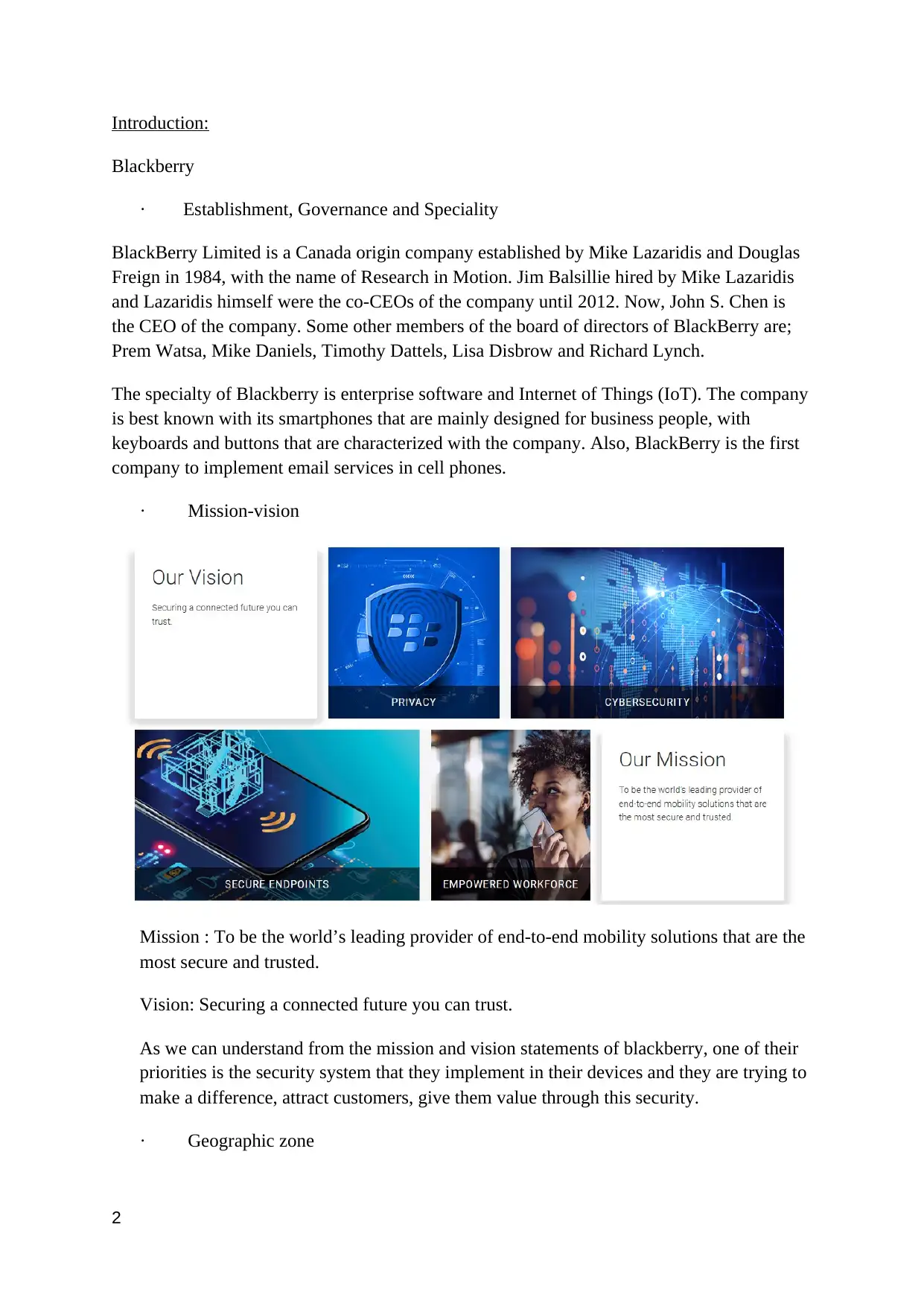
Introduction:
Blackberry
· Establishment, Governance and Speciality
BlackBerry Limited is a Canada origin company established by Mike Lazaridis and Douglas
Freign in 1984, with the name of Research in Motion. Jim Balsillie hired by Mike Lazaridis
and Lazaridis himself were the co-CEOs of the company until 2012. Now, John S. Chen is
the CEO of the company. Some other members of the board of directors of BlackBerry are;
Prem Watsa, Mike Daniels, Timothy Dattels, Lisa Disbrow and Richard Lynch.
The specialty of Blackberry is enterprise software and Internet of Things (IoT). The company
is best known with its smartphones that are mainly designed for business people, with
keyboards and buttons that are characterized with the company. Also, BlackBerry is the first
company to implement email services in cell phones.
· Mission-vision
Mission : To be the world’s leading provider of end-to-end mobility solutions that are the
most secure and trusted.
Vision: Securing a connected future you can trust.
As we can understand from the mission and vision statements of blackberry, one of their
priorities is the security system that they implement in their devices and they are trying to
make a difference, attract customers, give them value through this security.
· Geographic zone
2
Blackberry
· Establishment, Governance and Speciality
BlackBerry Limited is a Canada origin company established by Mike Lazaridis and Douglas
Freign in 1984, with the name of Research in Motion. Jim Balsillie hired by Mike Lazaridis
and Lazaridis himself were the co-CEOs of the company until 2012. Now, John S. Chen is
the CEO of the company. Some other members of the board of directors of BlackBerry are;
Prem Watsa, Mike Daniels, Timothy Dattels, Lisa Disbrow and Richard Lynch.
The specialty of Blackberry is enterprise software and Internet of Things (IoT). The company
is best known with its smartphones that are mainly designed for business people, with
keyboards and buttons that are characterized with the company. Also, BlackBerry is the first
company to implement email services in cell phones.
· Mission-vision
Mission : To be the world’s leading provider of end-to-end mobility solutions that are the
most secure and trusted.
Vision: Securing a connected future you can trust.
As we can understand from the mission and vision statements of blackberry, one of their
priorities is the security system that they implement in their devices and they are trying to
make a difference, attract customers, give them value through this security.
· Geographic zone
2
⊘ This is a preview!⊘
Do you want full access?
Subscribe today to unlock all pages.

Trusted by 1+ million students worldwide
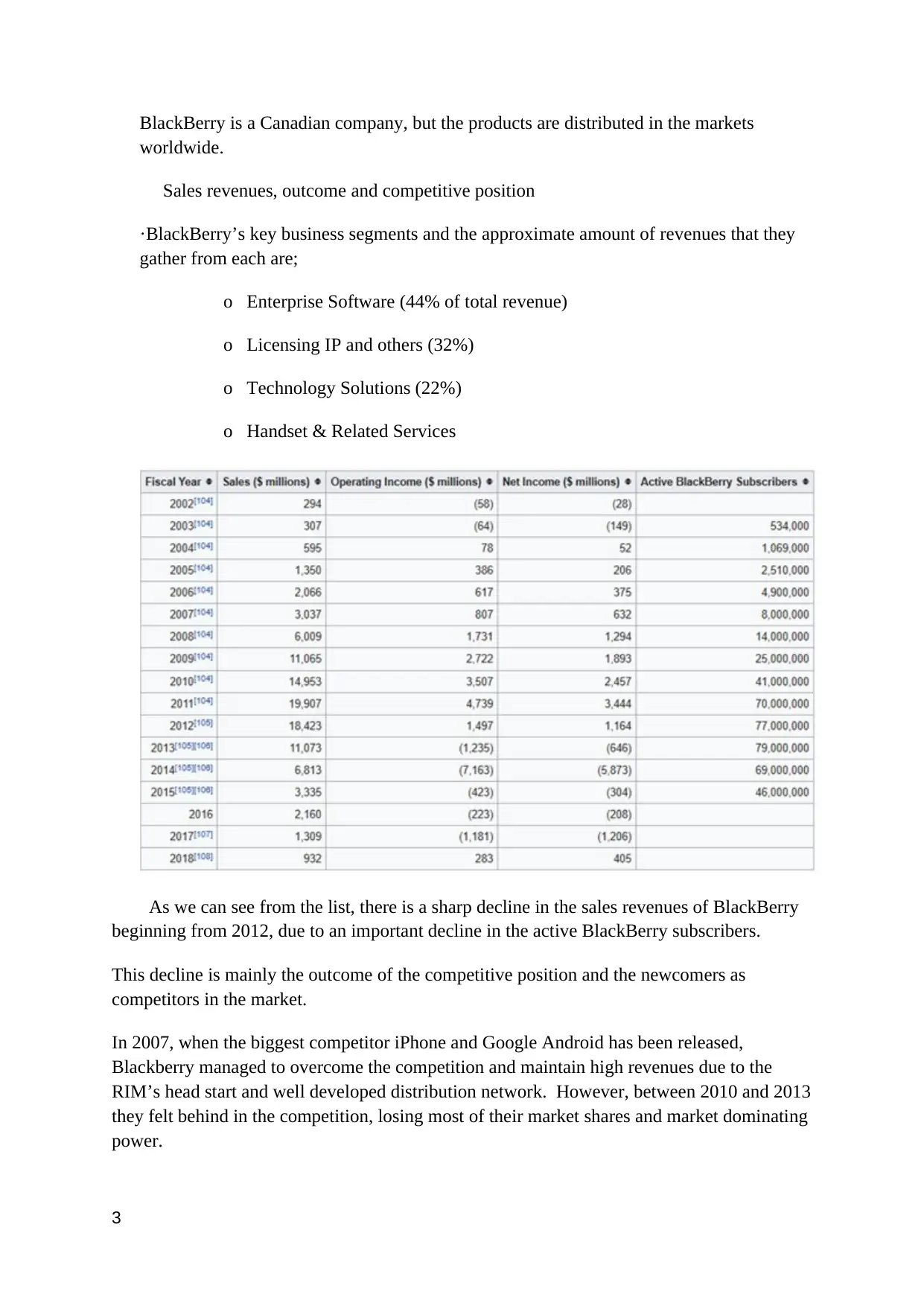
BlackBerry is a Canadian company, but the products are distributed in the markets
worldwide.
Sales revenues, outcome and competitive position
·BlackBerry’s key business segments and the approximate amount of revenues that they
gather from each are;
o Enterprise Software (44% of total revenue)
o Licensing IP and others (32%)
o Technology Solutions (22%)
o Handset & Related Services
As we can see from the list, there is a sharp decline in the sales revenues of BlackBerry
beginning from 2012, due to an important decline in the active BlackBerry subscribers.
This decline is mainly the outcome of the competitive position and the newcomers as
competitors in the market.
In 2007, when the biggest competitor iPhone and Google Android has been released,
Blackberry managed to overcome the competition and maintain high revenues due to the
RIM’s head start and well developed distribution network. However, between 2010 and 2013
they felt behind in the competition, losing most of their market shares and market dominating
power.
3
worldwide.
Sales revenues, outcome and competitive position
·BlackBerry’s key business segments and the approximate amount of revenues that they
gather from each are;
o Enterprise Software (44% of total revenue)
o Licensing IP and others (32%)
o Technology Solutions (22%)
o Handset & Related Services
As we can see from the list, there is a sharp decline in the sales revenues of BlackBerry
beginning from 2012, due to an important decline in the active BlackBerry subscribers.
This decline is mainly the outcome of the competitive position and the newcomers as
competitors in the market.
In 2007, when the biggest competitor iPhone and Google Android has been released,
Blackberry managed to overcome the competition and maintain high revenues due to the
RIM’s head start and well developed distribution network. However, between 2010 and 2013
they felt behind in the competition, losing most of their market shares and market dominating
power.
3
Paraphrase This Document
Need a fresh take? Get an instant paraphrase of this document with our AI Paraphraser
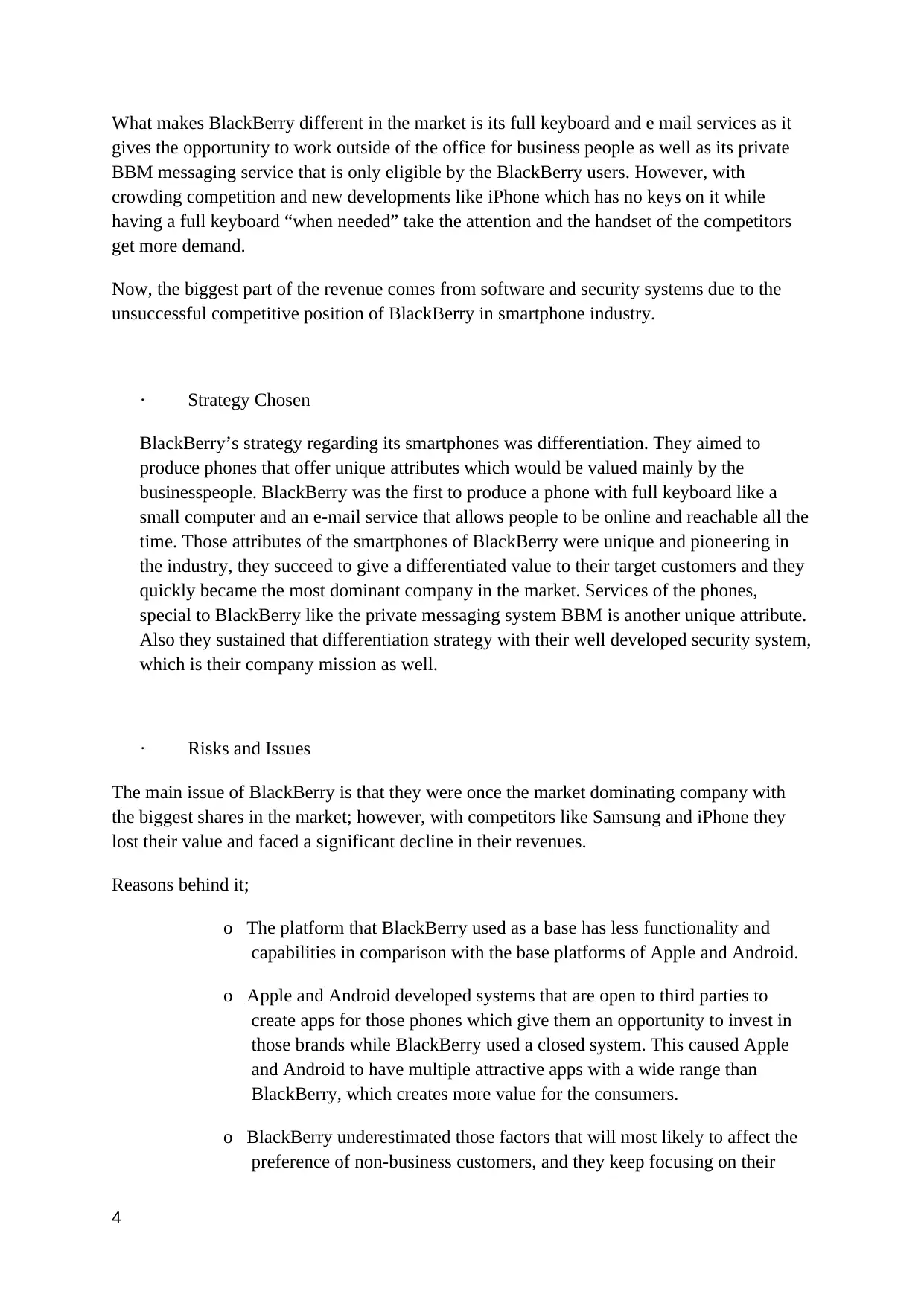
What makes BlackBerry different in the market is its full keyboard and e mail services as it
gives the opportunity to work outside of the office for business people as well as its private
BBM messaging service that is only eligible by the BlackBerry users. However, with
crowding competition and new developments like iPhone which has no keys on it while
having a full keyboard “when needed” take the attention and the handset of the competitors
get more demand.
Now, the biggest part of the revenue comes from software and security systems due to the
unsuccessful competitive position of BlackBerry in smartphone industry.
· Strategy Chosen
BlackBerry’s strategy regarding its smartphones was differentiation. They aimed to
produce phones that offer unique attributes which would be valued mainly by the
businesspeople. BlackBerry was the first to produce a phone with full keyboard like a
small computer and an e-mail service that allows people to be online and reachable all the
time. Those attributes of the smartphones of BlackBerry were unique and pioneering in
the industry, they succeed to give a differentiated value to their target customers and they
quickly became the most dominant company in the market. Services of the phones,
special to BlackBerry like the private messaging system BBM is another unique attribute.
Also they sustained that differentiation strategy with their well developed security system,
which is their company mission as well.
· Risks and Issues
The main issue of BlackBerry is that they were once the market dominating company with
the biggest shares in the market; however, with competitors like Samsung and iPhone they
lost their value and faced a significant decline in their revenues.
Reasons behind it;
o The platform that BlackBerry used as a base has less functionality and
capabilities in comparison with the base platforms of Apple and Android.
o Apple and Android developed systems that are open to third parties to
create apps for those phones which give them an opportunity to invest in
those brands while BlackBerry used a closed system. This caused Apple
and Android to have multiple attractive apps with a wide range than
BlackBerry, which creates more value for the consumers.
o BlackBerry underestimated those factors that will most likely to affect the
preference of non-business customers, and they keep focusing on their
4
gives the opportunity to work outside of the office for business people as well as its private
BBM messaging service that is only eligible by the BlackBerry users. However, with
crowding competition and new developments like iPhone which has no keys on it while
having a full keyboard “when needed” take the attention and the handset of the competitors
get more demand.
Now, the biggest part of the revenue comes from software and security systems due to the
unsuccessful competitive position of BlackBerry in smartphone industry.
· Strategy Chosen
BlackBerry’s strategy regarding its smartphones was differentiation. They aimed to
produce phones that offer unique attributes which would be valued mainly by the
businesspeople. BlackBerry was the first to produce a phone with full keyboard like a
small computer and an e-mail service that allows people to be online and reachable all the
time. Those attributes of the smartphones of BlackBerry were unique and pioneering in
the industry, they succeed to give a differentiated value to their target customers and they
quickly became the most dominant company in the market. Services of the phones,
special to BlackBerry like the private messaging system BBM is another unique attribute.
Also they sustained that differentiation strategy with their well developed security system,
which is their company mission as well.
· Risks and Issues
The main issue of BlackBerry is that they were once the market dominating company with
the biggest shares in the market; however, with competitors like Samsung and iPhone they
lost their value and faced a significant decline in their revenues.
Reasons behind it;
o The platform that BlackBerry used as a base has less functionality and
capabilities in comparison with the base platforms of Apple and Android.
o Apple and Android developed systems that are open to third parties to
create apps for those phones which give them an opportunity to invest in
those brands while BlackBerry used a closed system. This caused Apple
and Android to have multiple attractive apps with a wide range than
BlackBerry, which creates more value for the consumers.
o BlackBerry underestimated those factors that will most likely to affect the
preference of non-business customers, and they keep focusing on their
4
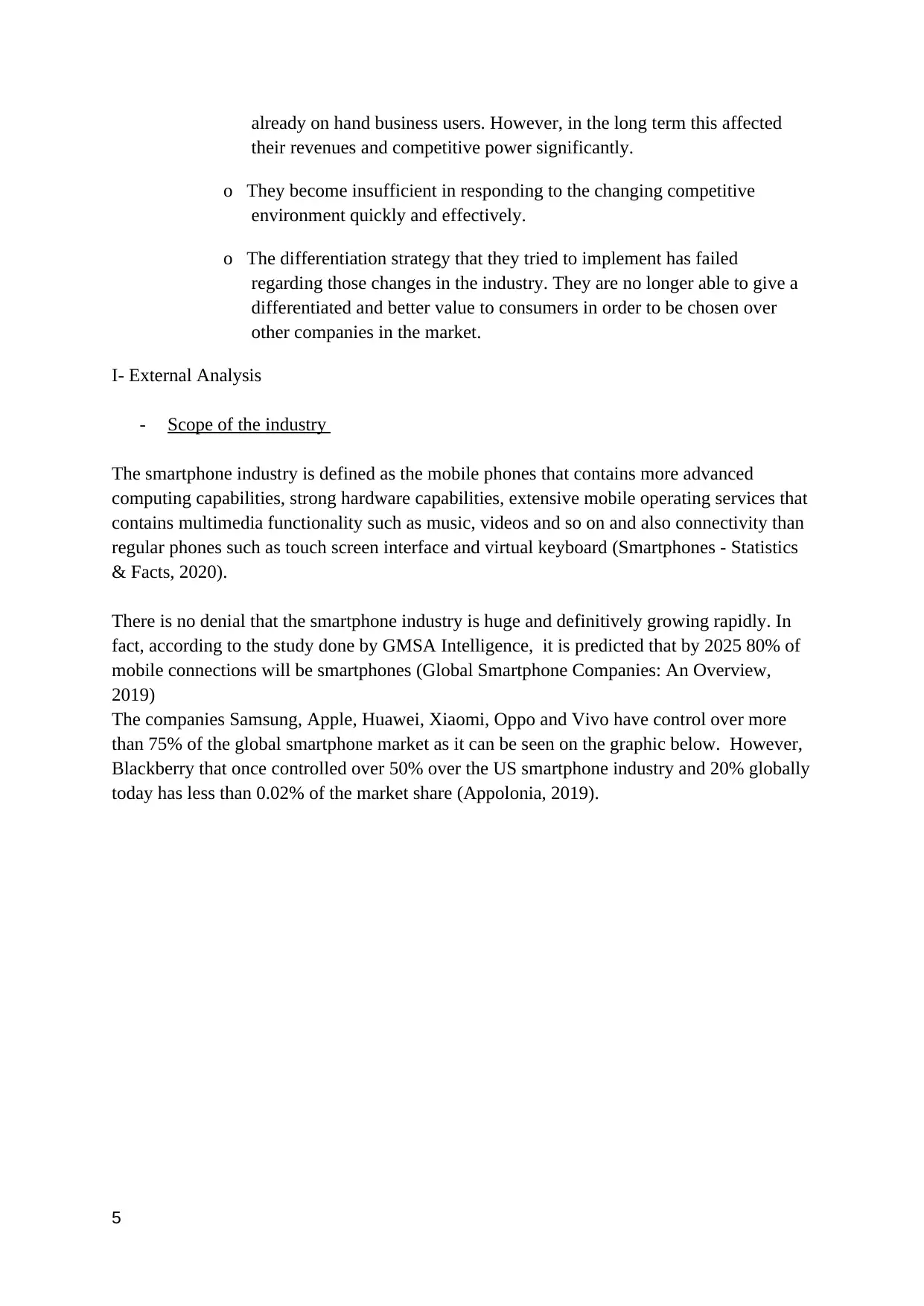
already on hand business users. However, in the long term this affected
their revenues and competitive power significantly.
o They become insufficient in responding to the changing competitive
environment quickly and effectively.
o The differentiation strategy that they tried to implement has failed
regarding those changes in the industry. They are no longer able to give a
differentiated and better value to consumers in order to be chosen over
other companies in the market.
I- External Analysis
- Scope of the industry
The smartphone industry is defined as the mobile phones that contains more advanced
computing capabilities, strong hardware capabilities, extensive mobile operating services that
contains multimedia functionality such as music, videos and so on and also connectivity than
regular phones such as touch screen interface and virtual keyboard (Smartphones - Statistics
& Facts, 2020).
There is no denial that the smartphone industry is huge and definitively growing rapidly. In
fact, according to the study done by GMSA Intelligence, it is predicted that by 2025 80% of
mobile connections will be smartphones (Global Smartphone Companies: An Overview,
2019)
The companies Samsung, Apple, Huawei, Xiaomi, Oppo and Vivo have control over more
than 75% of the global smartphone market as it can be seen on the graphic below. However,
Blackberry that once controlled over 50% over the US smartphone industry and 20% globally
today has less than 0.02% of the market share (Appolonia, 2019).
5
their revenues and competitive power significantly.
o They become insufficient in responding to the changing competitive
environment quickly and effectively.
o The differentiation strategy that they tried to implement has failed
regarding those changes in the industry. They are no longer able to give a
differentiated and better value to consumers in order to be chosen over
other companies in the market.
I- External Analysis
- Scope of the industry
The smartphone industry is defined as the mobile phones that contains more advanced
computing capabilities, strong hardware capabilities, extensive mobile operating services that
contains multimedia functionality such as music, videos and so on and also connectivity than
regular phones such as touch screen interface and virtual keyboard (Smartphones - Statistics
& Facts, 2020).
There is no denial that the smartphone industry is huge and definitively growing rapidly. In
fact, according to the study done by GMSA Intelligence, it is predicted that by 2025 80% of
mobile connections will be smartphones (Global Smartphone Companies: An Overview,
2019)
The companies Samsung, Apple, Huawei, Xiaomi, Oppo and Vivo have control over more
than 75% of the global smartphone market as it can be seen on the graphic below. However,
Blackberry that once controlled over 50% over the US smartphone industry and 20% globally
today has less than 0.02% of the market share (Appolonia, 2019).
5
⊘ This is a preview!⊘
Do you want full access?
Subscribe today to unlock all pages.

Trusted by 1+ million students worldwide
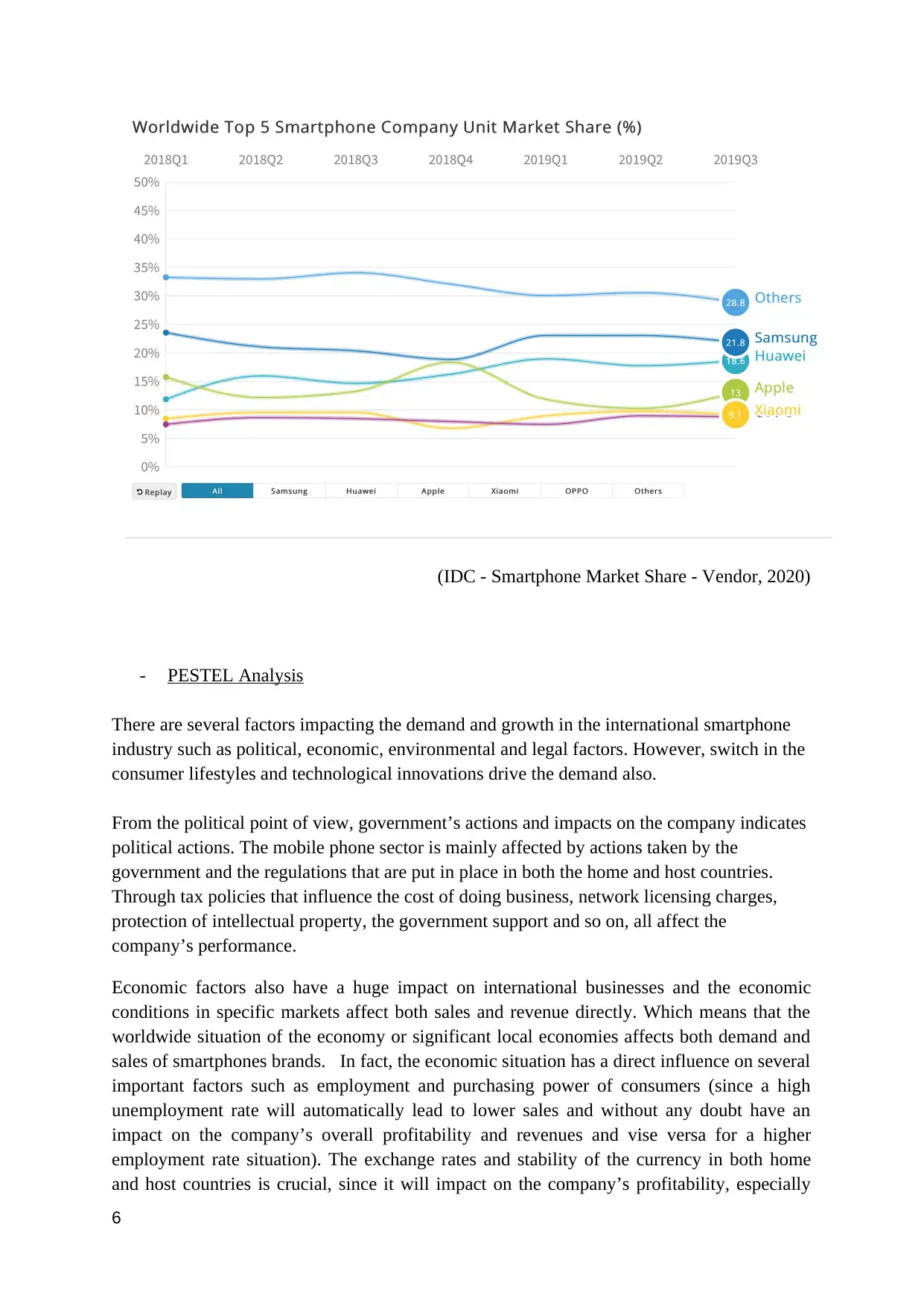
(IDC - Smartphone Market Share - Vendor, 2020)
- PESTEL Analysis
There are several factors impacting the demand and growth in the international smartphone
industry such as political, economic, environmental and legal factors. However, switch in the
consumer lifestyles and technological innovations drive the demand also.
From the political point of view, government’s actions and impacts on the company indicates
political actions. The mobile phone sector is mainly affected by actions taken by the
government and the regulations that are put in place in both the home and host countries.
Through tax policies that influence the cost of doing business, network licensing charges,
protection of intellectual property, the government support and so on, all affect the
company’s performance.
Economic factors also have a huge impact on international businesses and the economic
conditions in specific markets affect both sales and revenue directly. Which means that the
worldwide situation of the economy or significant local economies affects both demand and
sales of smartphones brands. In fact, the economic situation has a direct influence on several
important factors such as employment and purchasing power of consumers (since a high
unemployment rate will automatically lead to lower sales and without any doubt have an
impact on the company’s overall profitability and revenues and vise versa for a higher
employment rate situation). The exchange rates and stability of the currency in both home
and host countries is crucial, since it will impact on the company’s profitability, especially
6
- PESTEL Analysis
There are several factors impacting the demand and growth in the international smartphone
industry such as political, economic, environmental and legal factors. However, switch in the
consumer lifestyles and technological innovations drive the demand also.
From the political point of view, government’s actions and impacts on the company indicates
political actions. The mobile phone sector is mainly affected by actions taken by the
government and the regulations that are put in place in both the home and host countries.
Through tax policies that influence the cost of doing business, network licensing charges,
protection of intellectual property, the government support and so on, all affect the
company’s performance.
Economic factors also have a huge impact on international businesses and the economic
conditions in specific markets affect both sales and revenue directly. Which means that the
worldwide situation of the economy or significant local economies affects both demand and
sales of smartphones brands. In fact, the economic situation has a direct influence on several
important factors such as employment and purchasing power of consumers (since a high
unemployment rate will automatically lead to lower sales and without any doubt have an
impact on the company’s overall profitability and revenues and vise versa for a higher
employment rate situation). The exchange rates and stability of the currency in both home
and host countries is crucial, since it will impact on the company’s profitability, especially
6
Paraphrase This Document
Need a fresh take? Get an instant paraphrase of this document with our AI Paraphraser
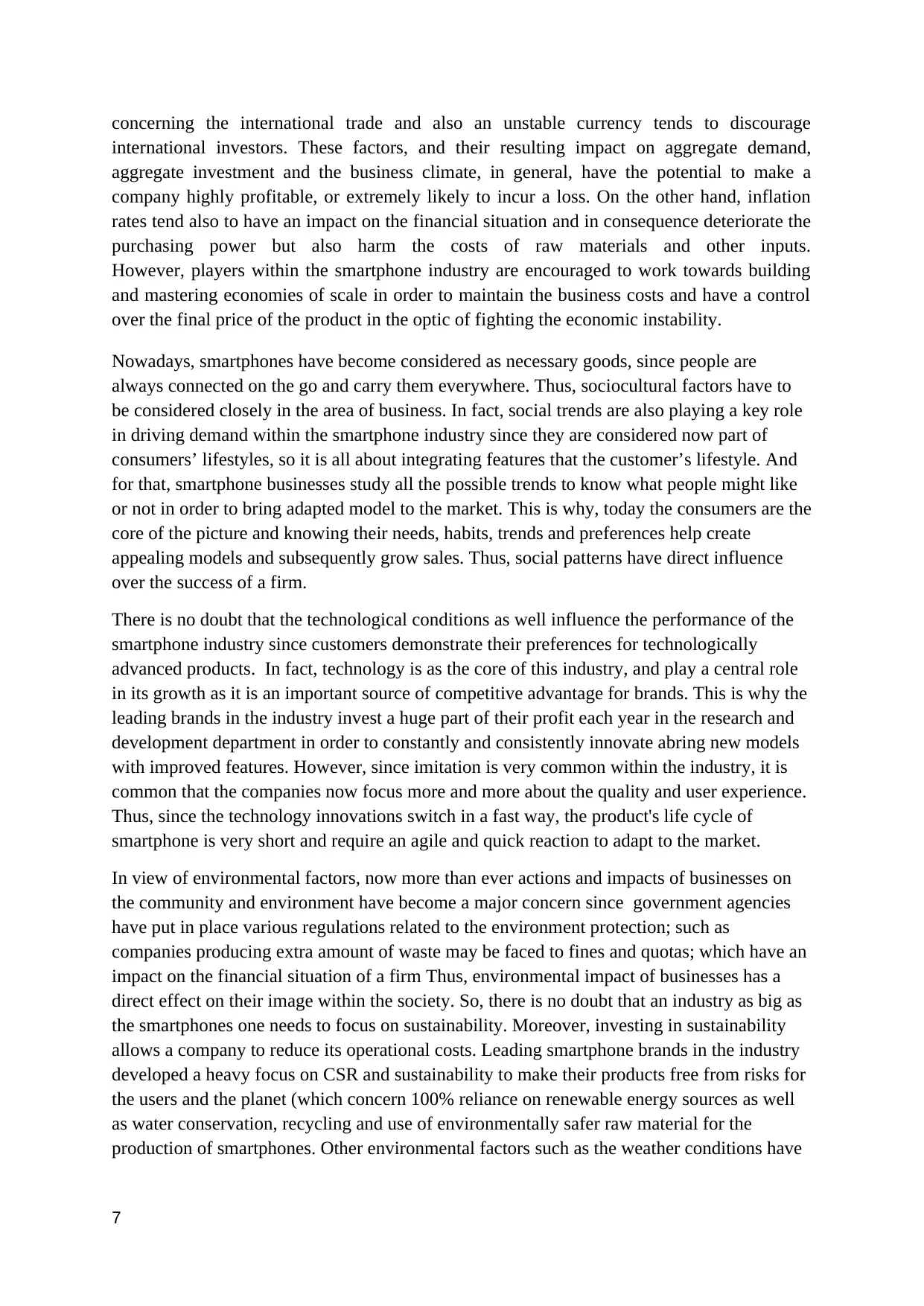
concerning the international trade and also an unstable currency tends to discourage
international investors. These factors, and their resulting impact on aggregate demand,
aggregate investment and the business climate, in general, have the potential to make a
company highly profitable, or extremely likely to incur a loss. On the other hand, inflation
rates tend also to have an impact on the financial situation and in consequence deteriorate the
purchasing power but also harm the costs of raw materials and other inputs.
However, players within the smartphone industry are encouraged to work towards building
and mastering economies of scale in order to maintain the business costs and have a control
over the final price of the product in the optic of fighting the economic instability.
Nowadays, smartphones have become considered as necessary goods, since people are
always connected on the go and carry them everywhere. Thus, sociocultural factors have to
be considered closely in the area of business. In fact, social trends are also playing a key role
in driving demand within the smartphone industry since they are considered now part of
consumers’ lifestyles, so it is all about integrating features that the customer’s lifestyle. And
for that, smartphone businesses study all the possible trends to know what people might like
or not in order to bring adapted model to the market. This is why, today the consumers are the
core of the picture and knowing their needs, habits, trends and preferences help create
appealing models and subsequently grow sales. Thus, social patterns have direct influence
over the success of a firm.
There is no doubt that the technological conditions as well influence the performance of the
smartphone industry since customers demonstrate their preferences for technologically
advanced products. In fact, technology is as the core of this industry, and play a central role
in its growth as it is an important source of competitive advantage for brands. This is why the
leading brands in the industry invest a huge part of their profit each year in the research and
development department in order to constantly and consistently innovate abring new models
with improved features. However, since imitation is very common within the industry, it is
common that the companies now focus more and more about the quality and user experience.
Thus, since the technology innovations switch in a fast way, the product's life cycle of
smartphone is very short and require an agile and quick reaction to adapt to the market.
In view of environmental factors, now more than ever actions and impacts of businesses on
the community and environment have become a major concern since government agencies
have put in place various regulations related to the environment protection; such as
companies producing extra amount of waste may be faced to fines and quotas; which have an
impact on the financial situation of a firm Thus, environmental impact of businesses has a
direct effect on their image within the society. So, there is no doubt that an industry as big as
the smartphones one needs to focus on sustainability. Moreover, investing in sustainability
allows a company to reduce its operational costs. Leading smartphone brands in the industry
developed a heavy focus on CSR and sustainability to make their products free from risks for
the users and the planet (which concern 100% reliance on renewable energy sources as well
as water conservation, recycling and use of environmentally safer raw material for the
production of smartphones. Other environmental factors such as the weather conditions have
7
international investors. These factors, and their resulting impact on aggregate demand,
aggregate investment and the business climate, in general, have the potential to make a
company highly profitable, or extremely likely to incur a loss. On the other hand, inflation
rates tend also to have an impact on the financial situation and in consequence deteriorate the
purchasing power but also harm the costs of raw materials and other inputs.
However, players within the smartphone industry are encouraged to work towards building
and mastering economies of scale in order to maintain the business costs and have a control
over the final price of the product in the optic of fighting the economic instability.
Nowadays, smartphones have become considered as necessary goods, since people are
always connected on the go and carry them everywhere. Thus, sociocultural factors have to
be considered closely in the area of business. In fact, social trends are also playing a key role
in driving demand within the smartphone industry since they are considered now part of
consumers’ lifestyles, so it is all about integrating features that the customer’s lifestyle. And
for that, smartphone businesses study all the possible trends to know what people might like
or not in order to bring adapted model to the market. This is why, today the consumers are the
core of the picture and knowing their needs, habits, trends and preferences help create
appealing models and subsequently grow sales. Thus, social patterns have direct influence
over the success of a firm.
There is no doubt that the technological conditions as well influence the performance of the
smartphone industry since customers demonstrate their preferences for technologically
advanced products. In fact, technology is as the core of this industry, and play a central role
in its growth as it is an important source of competitive advantage for brands. This is why the
leading brands in the industry invest a huge part of their profit each year in the research and
development department in order to constantly and consistently innovate abring new models
with improved features. However, since imitation is very common within the industry, it is
common that the companies now focus more and more about the quality and user experience.
Thus, since the technology innovations switch in a fast way, the product's life cycle of
smartphone is very short and require an agile and quick reaction to adapt to the market.
In view of environmental factors, now more than ever actions and impacts of businesses on
the community and environment have become a major concern since government agencies
have put in place various regulations related to the environment protection; such as
companies producing extra amount of waste may be faced to fines and quotas; which have an
impact on the financial situation of a firm Thus, environmental impact of businesses has a
direct effect on their image within the society. So, there is no doubt that an industry as big as
the smartphones one needs to focus on sustainability. Moreover, investing in sustainability
allows a company to reduce its operational costs. Leading smartphone brands in the industry
developed a heavy focus on CSR and sustainability to make their products free from risks for
the users and the planet (which concern 100% reliance on renewable energy sources as well
as water conservation, recycling and use of environmentally safer raw material for the
production of smartphones. Other environmental factors such as the weather conditions have
7
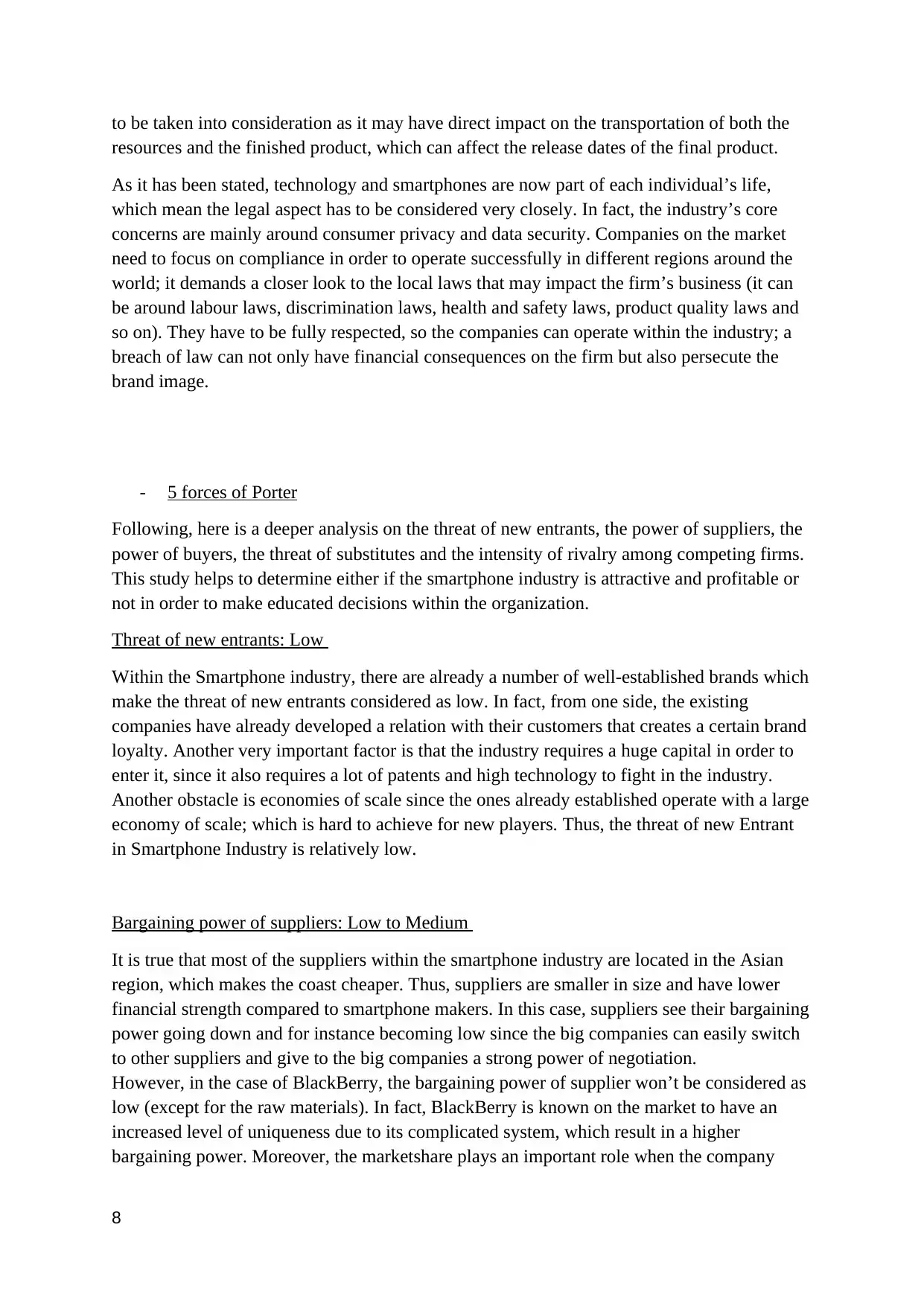
to be taken into consideration as it may have direct impact on the transportation of both the
resources and the finished product, which can affect the release dates of the final product.
As it has been stated, technology and smartphones are now part of each individual’s life,
which mean the legal aspect has to be considered very closely. In fact, the industry’s core
concerns are mainly around consumer privacy and data security. Companies on the market
need to focus on compliance in order to operate successfully in different regions around the
world; it demands a closer look to the local laws that may impact the firm’s business (it can
be around labour laws, discrimination laws, health and safety laws, product quality laws and
so on). They have to be fully respected, so the companies can operate within the industry; a
breach of law can not only have financial consequences on the firm but also persecute the
brand image.
- 5 forces of Porter
Following, here is a deeper analysis on the threat of new entrants, the power of suppliers, the
power of buyers, the threat of substitutes and the intensity of rivalry among competing firms.
This study helps to determine either if the smartphone industry is attractive and profitable or
not in order to make educated decisions within the organization.
Threat of new entrants: Low
Within the Smartphone industry, there are already a number of well-established brands which
make the threat of new entrants considered as low. In fact, from one side, the existing
companies have already developed a relation with their customers that creates a certain brand
loyalty. Another very important factor is that the industry requires a huge capital in order to
enter it, since it also requires a lot of patents and high technology to fight in the industry.
Another obstacle is economies of scale since the ones already established operate with a large
economy of scale; which is hard to achieve for new players. Thus, the threat of new Entrant
in Smartphone Industry is relatively low.
Bargaining power of suppliers: Low to Medium
It is true that most of the suppliers within the smartphone industry are located in the Asian
region, which makes the coast cheaper. Thus, suppliers are smaller in size and have lower
financial strength compared to smartphone makers. In this case, suppliers see their bargaining
power going down and for instance becoming low since the big companies can easily switch
to other suppliers and give to the big companies a strong power of negotiation.
However, in the case of BlackBerry, the bargaining power of supplier won’t be considered as
low (except for the raw materials). In fact, BlackBerry is known on the market to have an
increased level of uniqueness due to its complicated system, which result in a higher
bargaining power. Moreover, the marketshare plays an important role when the company
8
resources and the finished product, which can affect the release dates of the final product.
As it has been stated, technology and smartphones are now part of each individual’s life,
which mean the legal aspect has to be considered very closely. In fact, the industry’s core
concerns are mainly around consumer privacy and data security. Companies on the market
need to focus on compliance in order to operate successfully in different regions around the
world; it demands a closer look to the local laws that may impact the firm’s business (it can
be around labour laws, discrimination laws, health and safety laws, product quality laws and
so on). They have to be fully respected, so the companies can operate within the industry; a
breach of law can not only have financial consequences on the firm but also persecute the
brand image.
- 5 forces of Porter
Following, here is a deeper analysis on the threat of new entrants, the power of suppliers, the
power of buyers, the threat of substitutes and the intensity of rivalry among competing firms.
This study helps to determine either if the smartphone industry is attractive and profitable or
not in order to make educated decisions within the organization.
Threat of new entrants: Low
Within the Smartphone industry, there are already a number of well-established brands which
make the threat of new entrants considered as low. In fact, from one side, the existing
companies have already developed a relation with their customers that creates a certain brand
loyalty. Another very important factor is that the industry requires a huge capital in order to
enter it, since it also requires a lot of patents and high technology to fight in the industry.
Another obstacle is economies of scale since the ones already established operate with a large
economy of scale; which is hard to achieve for new players. Thus, the threat of new Entrant
in Smartphone Industry is relatively low.
Bargaining power of suppliers: Low to Medium
It is true that most of the suppliers within the smartphone industry are located in the Asian
region, which makes the coast cheaper. Thus, suppliers are smaller in size and have lower
financial strength compared to smartphone makers. In this case, suppliers see their bargaining
power going down and for instance becoming low since the big companies can easily switch
to other suppliers and give to the big companies a strong power of negotiation.
However, in the case of BlackBerry, the bargaining power of supplier won’t be considered as
low (except for the raw materials). In fact, BlackBerry is known on the market to have an
increased level of uniqueness due to its complicated system, which result in a higher
bargaining power. Moreover, the marketshare plays an important role when the company
8
⊘ This is a preview!⊘
Do you want full access?
Subscribe today to unlock all pages.

Trusted by 1+ million students worldwide
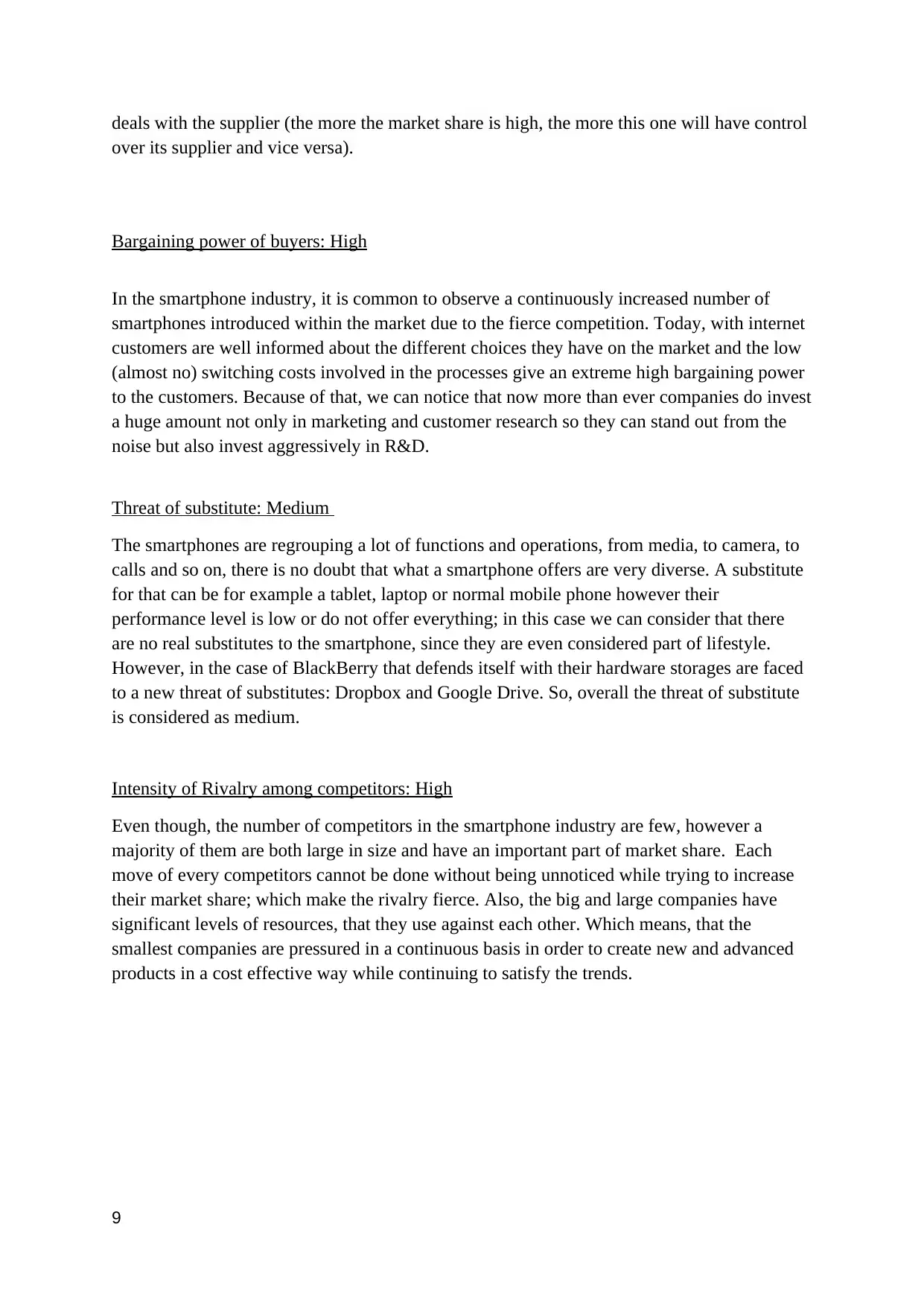
deals with the supplier (the more the market share is high, the more this one will have control
over its supplier and vice versa).
Bargaining power of buyers: High
In the smartphone industry, it is common to observe a continuously increased number of
smartphones introduced within the market due to the fierce competition. Today, with internet
customers are well informed about the different choices they have on the market and the low
(almost no) switching costs involved in the processes give an extreme high bargaining power
to the customers. Because of that, we can notice that now more than ever companies do invest
a huge amount not only in marketing and customer research so they can stand out from the
noise but also invest aggressively in R&D.
Threat of substitute: Medium
The smartphones are regrouping a lot of functions and operations, from media, to camera, to
calls and so on, there is no doubt that what a smartphone offers are very diverse. A substitute
for that can be for example a tablet, laptop or normal mobile phone however their
performance level is low or do not offer everything; in this case we can consider that there
are no real substitutes to the smartphone, since they are even considered part of lifestyle.
However, in the case of BlackBerry that defends itself with their hardware storages are faced
to a new threat of substitutes: Dropbox and Google Drive. So, overall the threat of substitute
is considered as medium.
Intensity of Rivalry among competitors: High
Even though, the number of competitors in the smartphone industry are few, however a
majority of them are both large in size and have an important part of market share. Each
move of every competitors cannot be done without being unnoticed while trying to increase
their market share; which make the rivalry fierce. Also, the big and large companies have
significant levels of resources, that they use against each other. Which means, that the
smallest companies are pressured in a continuous basis in order to create new and advanced
products in a cost effective way while continuing to satisfy the trends.
9
over its supplier and vice versa).
Bargaining power of buyers: High
In the smartphone industry, it is common to observe a continuously increased number of
smartphones introduced within the market due to the fierce competition. Today, with internet
customers are well informed about the different choices they have on the market and the low
(almost no) switching costs involved in the processes give an extreme high bargaining power
to the customers. Because of that, we can notice that now more than ever companies do invest
a huge amount not only in marketing and customer research so they can stand out from the
noise but also invest aggressively in R&D.
Threat of substitute: Medium
The smartphones are regrouping a lot of functions and operations, from media, to camera, to
calls and so on, there is no doubt that what a smartphone offers are very diverse. A substitute
for that can be for example a tablet, laptop or normal mobile phone however their
performance level is low or do not offer everything; in this case we can consider that there
are no real substitutes to the smartphone, since they are even considered part of lifestyle.
However, in the case of BlackBerry that defends itself with their hardware storages are faced
to a new threat of substitutes: Dropbox and Google Drive. So, overall the threat of substitute
is considered as medium.
Intensity of Rivalry among competitors: High
Even though, the number of competitors in the smartphone industry are few, however a
majority of them are both large in size and have an important part of market share. Each
move of every competitors cannot be done without being unnoticed while trying to increase
their market share; which make the rivalry fierce. Also, the big and large companies have
significant levels of resources, that they use against each other. Which means, that the
smallest companies are pressured in a continuous basis in order to create new and advanced
products in a cost effective way while continuing to satisfy the trends.
9
Paraphrase This Document
Need a fresh take? Get an instant paraphrase of this document with our AI Paraphraser
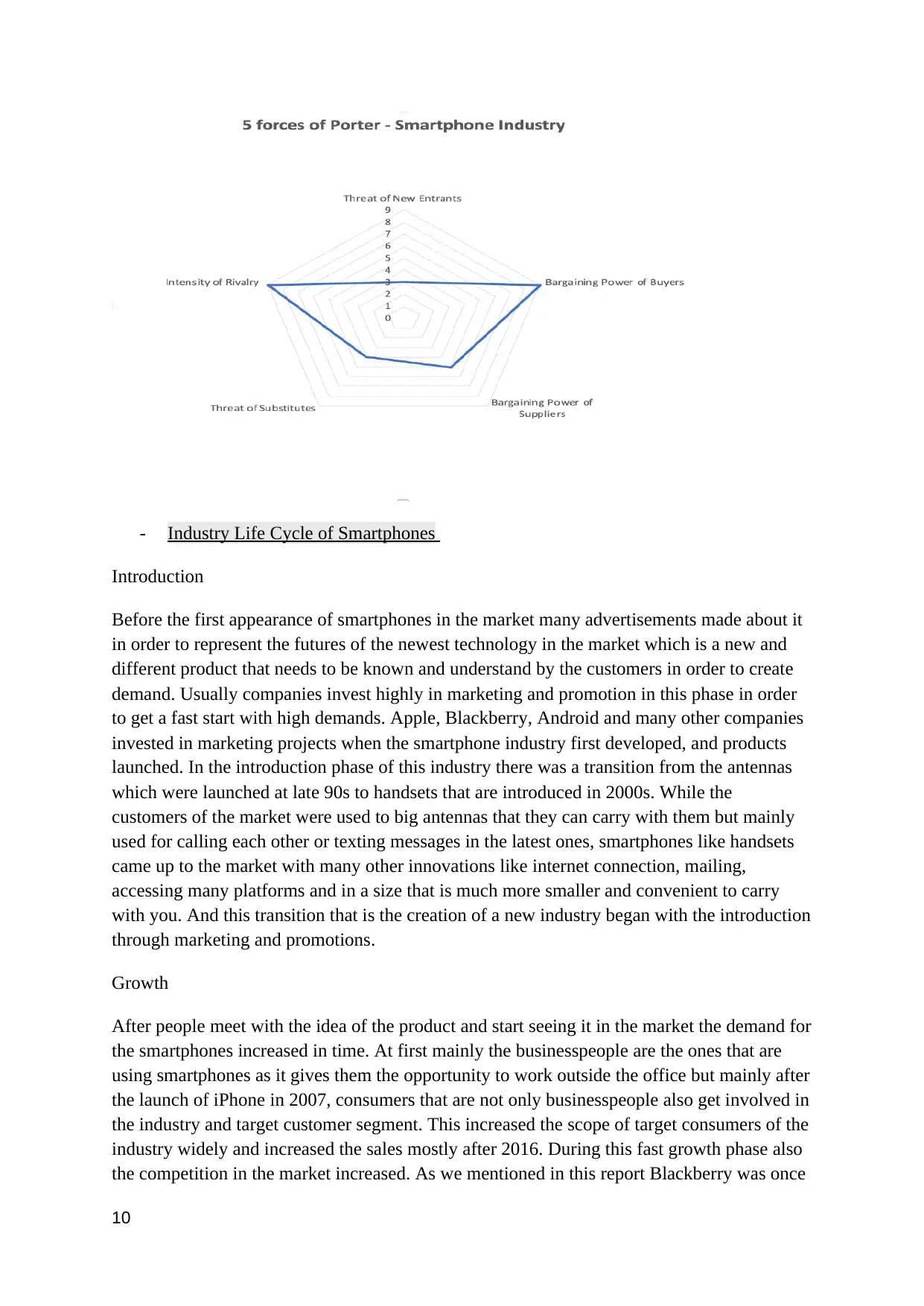
- Industry Life Cycle of Smartphones
Introduction
Before the first appearance of smartphones in the market many advertisements made about it
in order to represent the futures of the newest technology in the market which is a new and
different product that needs to be known and understand by the customers in order to create
demand. Usually companies invest highly in marketing and promotion in this phase in order
to get a fast start with high demands. Apple, Blackberry, Android and many other companies
invested in marketing projects when the smartphone industry first developed, and products
launched. In the introduction phase of this industry there was a transition from the antennas
which were launched at late 90s to handsets that are introduced in 2000s. While the
customers of the market were used to big antennas that they can carry with them but mainly
used for calling each other or texting messages in the latest ones, smartphones like handsets
came up to the market with many other innovations like internet connection, mailing,
accessing many platforms and in a size that is much more smaller and convenient to carry
with you. And this transition that is the creation of a new industry began with the introduction
through marketing and promotions.
Growth
After people meet with the idea of the product and start seeing it in the market the demand for
the smartphones increased in time. At first mainly the businesspeople are the ones that are
using smartphones as it gives them the opportunity to work outside the office but mainly after
the launch of iPhone in 2007, consumers that are not only businesspeople also get involved in
the industry and target customer segment. This increased the scope of target consumers of the
industry widely and increased the sales mostly after 2016. During this fast growth phase also
the competition in the market increased. As we mentioned in this report Blackberry was once
10
Introduction
Before the first appearance of smartphones in the market many advertisements made about it
in order to represent the futures of the newest technology in the market which is a new and
different product that needs to be known and understand by the customers in order to create
demand. Usually companies invest highly in marketing and promotion in this phase in order
to get a fast start with high demands. Apple, Blackberry, Android and many other companies
invested in marketing projects when the smartphone industry first developed, and products
launched. In the introduction phase of this industry there was a transition from the antennas
which were launched at late 90s to handsets that are introduced in 2000s. While the
customers of the market were used to big antennas that they can carry with them but mainly
used for calling each other or texting messages in the latest ones, smartphones like handsets
came up to the market with many other innovations like internet connection, mailing,
accessing many platforms and in a size that is much more smaller and convenient to carry
with you. And this transition that is the creation of a new industry began with the introduction
through marketing and promotions.
Growth
After people meet with the idea of the product and start seeing it in the market the demand for
the smartphones increased in time. At first mainly the businesspeople are the ones that are
using smartphones as it gives them the opportunity to work outside the office but mainly after
the launch of iPhone in 2007, consumers that are not only businesspeople also get involved in
the industry and target customer segment. This increased the scope of target consumers of the
industry widely and increased the sales mostly after 2016. During this fast growth phase also
the competition in the market increased. As we mentioned in this report Blackberry was once
10
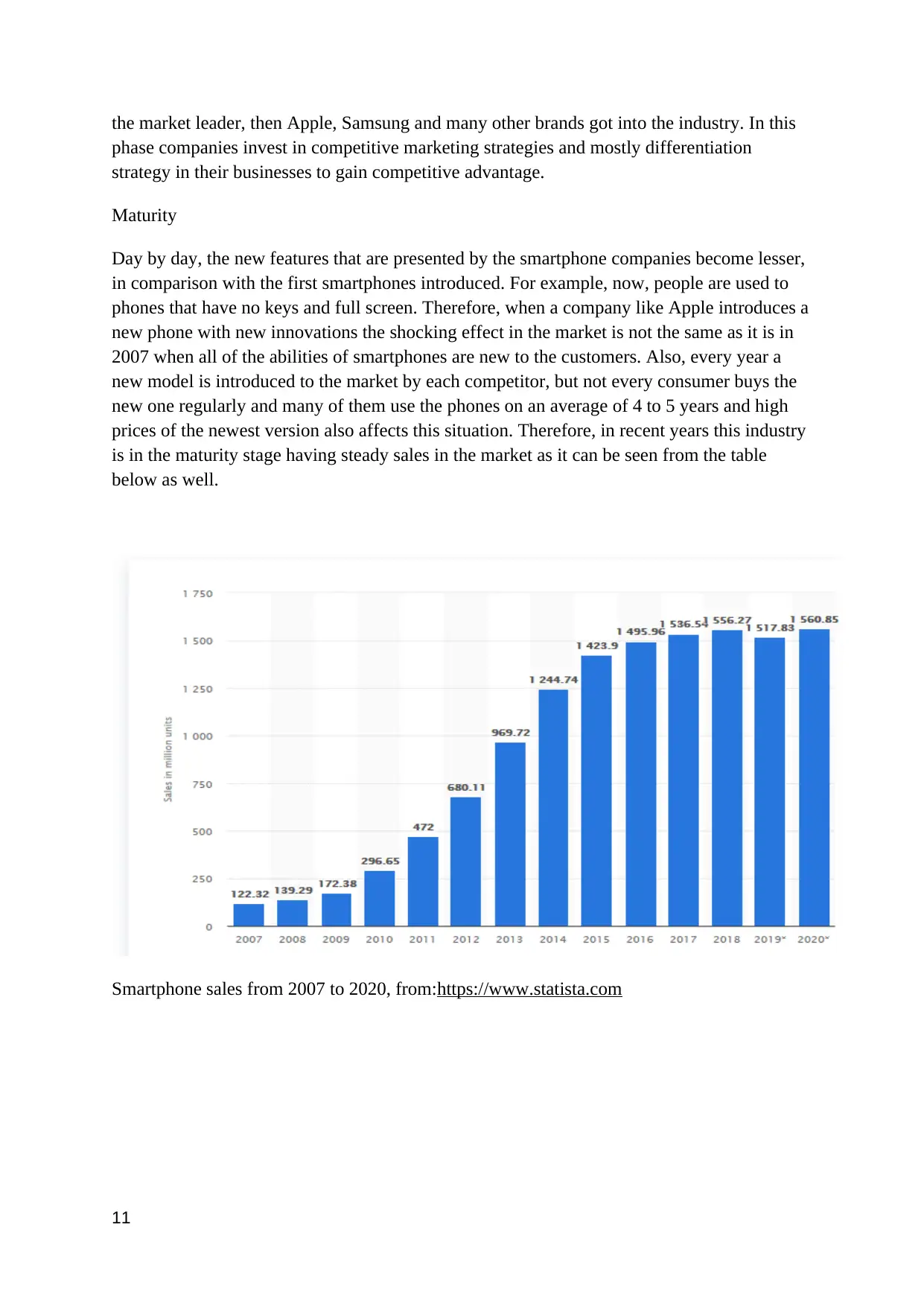
the market leader, then Apple, Samsung and many other brands got into the industry. In this
phase companies invest in competitive marketing strategies and mostly differentiation
strategy in their businesses to gain competitive advantage.
Maturity
Day by day, the new features that are presented by the smartphone companies become lesser,
in comparison with the first smartphones introduced. For example, now, people are used to
phones that have no keys and full screen. Therefore, when a company like Apple introduces a
new phone with new innovations the shocking effect in the market is not the same as it is in
2007 when all of the abilities of smartphones are new to the customers. Also, every year a
new model is introduced to the market by each competitor, but not every consumer buys the
new one regularly and many of them use the phones on an average of 4 to 5 years and high
prices of the newest version also affects this situation. Therefore, in recent years this industry
is in the maturity stage having steady sales in the market as it can be seen from the table
below as well.
Smartphone sales from 2007 to 2020, from:https://www.statista.com
11
phase companies invest in competitive marketing strategies and mostly differentiation
strategy in their businesses to gain competitive advantage.
Maturity
Day by day, the new features that are presented by the smartphone companies become lesser,
in comparison with the first smartphones introduced. For example, now, people are used to
phones that have no keys and full screen. Therefore, when a company like Apple introduces a
new phone with new innovations the shocking effect in the market is not the same as it is in
2007 when all of the abilities of smartphones are new to the customers. Also, every year a
new model is introduced to the market by each competitor, but not every consumer buys the
new one regularly and many of them use the phones on an average of 4 to 5 years and high
prices of the newest version also affects this situation. Therefore, in recent years this industry
is in the maturity stage having steady sales in the market as it can be seen from the table
below as well.
Smartphone sales from 2007 to 2020, from:https://www.statista.com
11
⊘ This is a preview!⊘
Do you want full access?
Subscribe today to unlock all pages.

Trusted by 1+ million students worldwide
1 out of 22
Your All-in-One AI-Powered Toolkit for Academic Success.
+13062052269
info@desklib.com
Available 24*7 on WhatsApp / Email
![[object Object]](/_next/static/media/star-bottom.7253800d.svg)
Unlock your academic potential
Copyright © 2020–2025 A2Z Services. All Rights Reserved. Developed and managed by ZUCOL.